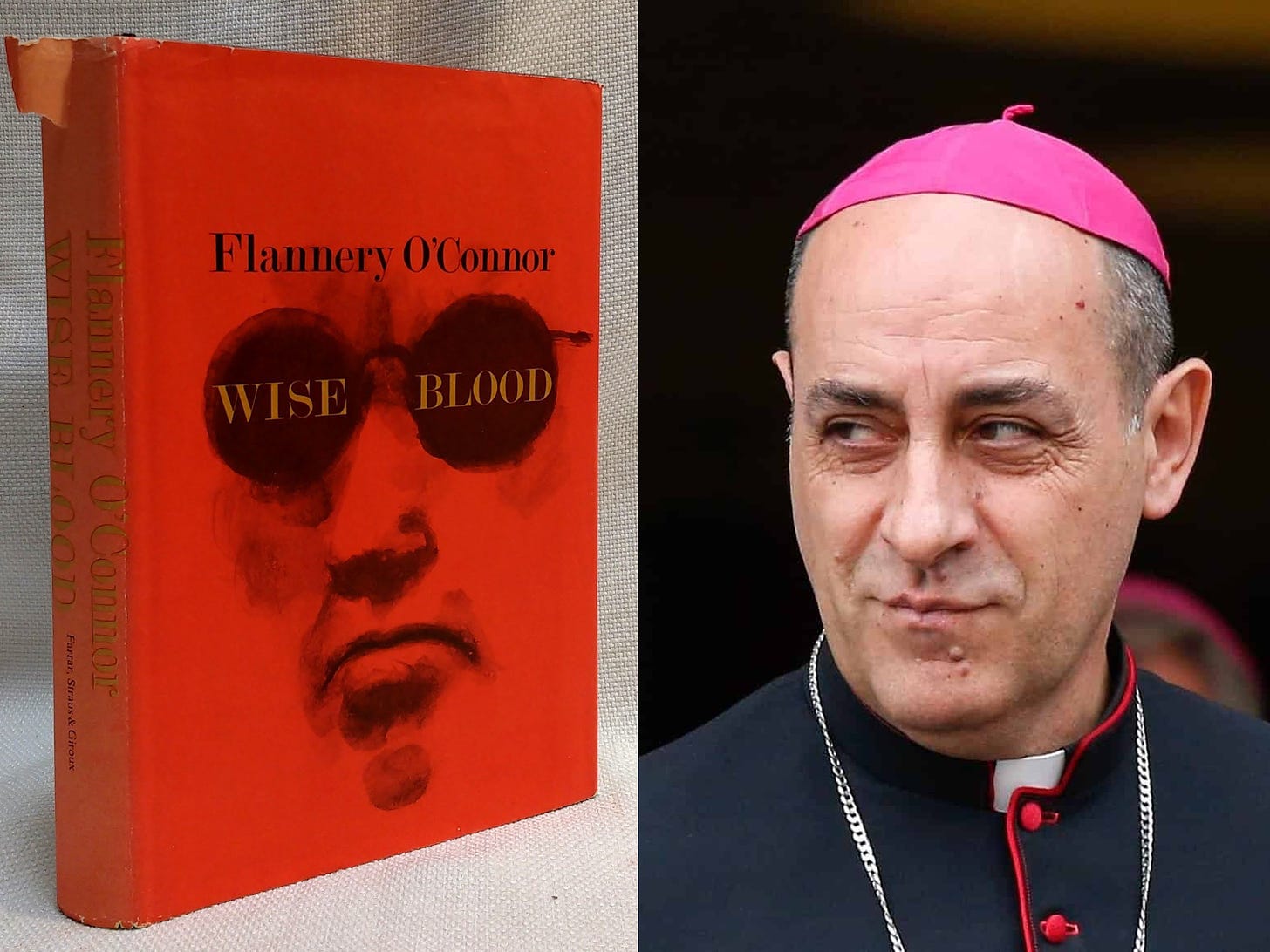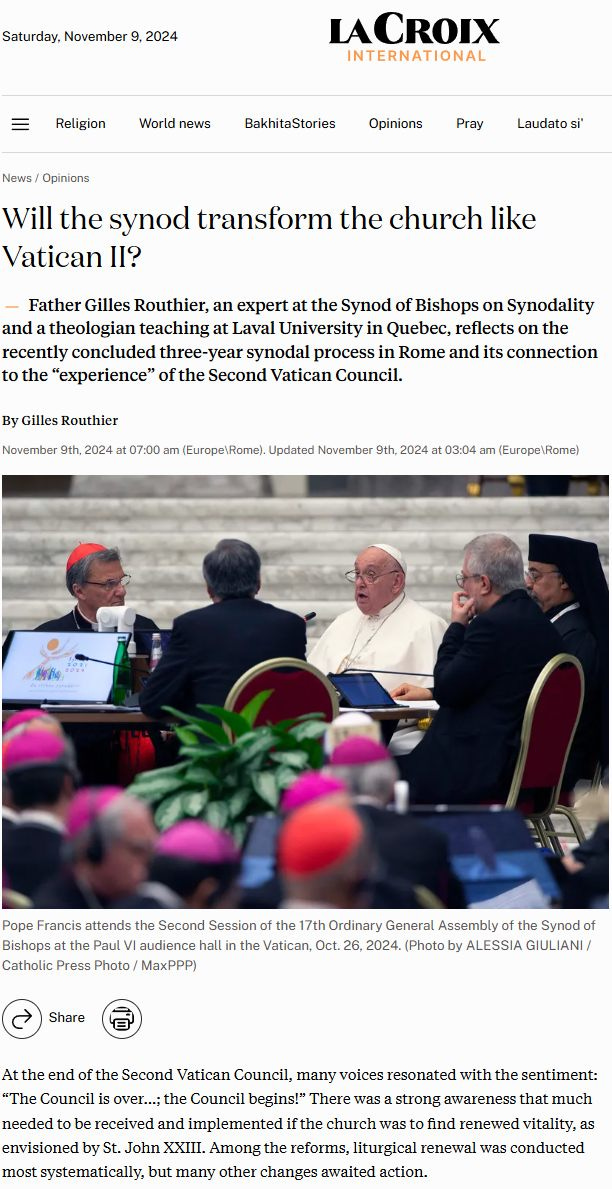The “new jesus” of Our Times + Weekly Roundup, November 15th
Hazel Motes and the Synod's fake religion: a guest perspective
Just below, after a special feature, I’ll come to the usual Weekly Roundup, which many readers tell me they look forward to each Friday as they find it quite useful for keeping up with current commentary, the state of the liturgy, various events, good news, and the like. I hope it truly is helpful, as that’s the whole reason I decided to create it. And… if you do find the material here consistently beneficial, please take out a paid subscription to help Tradition & Sanity stay afloat for the long haul:
If you’re already subscribed, consider giving a gift subscription to a friend or a relative (and don’t forget the clergy!):
Or, if you just want to say a little “thank you,” there’s no better way to do it than to buy me an espresso (for reasons that are made plain at “An Espresso Reverie,” published here a year ago):
Now for our special feature today…
You may recall that back in May, I published a piece called:
Well, one of the reactions I received to the article was a delightful surprise — a short article submitted by a reader, Nathaniel Richards! (Thank you, sir.) I very much enjoyed what he had to say and I think the rest of you will also appreciate it, so I’m finally getting around to posting it here. The month of November somehow seems appropriate, in my mind, for the strange, quasi-apocalyptic sense of humor that shines through the fiction of O’Connor. Enjoy! ~ Dr. K
The “new jesus” of Our Times
In Flannery O’Connor’s debut novel, Wise Blood,1 we are introduced to Hazel Motes, a young man recently discharged from the military who has taken upon himself the burden of starting “The Church Without Christ.” His unique brand of anti-evangelism begins in a manner typical of those revivalist preachers in the American South of the early to mid-twentieth century. Thus, he preaches in the streets in front of the local theaters and sometimes stands on the hood of his car to spread his message.
The gist of Hazel’s message and his newfound church? “The Church Without Christ don’t have a Jesus,” he says,
but it needs one. It needs a new jesus! It needs one that’s all man, without blood to waste, and it needs one that don’t look like any other man so you’ll look at him. Give me such a jesus, you people. Give me such a new jesus and you’ll see how far the Church Without Christ can go! (80)
But Hazel’s message doesn’t quite gather the anti-Christian converts he desires. When preaching outside the picture shows one night, Hazel notices a man winking at him while he preaches. Eventually, this man begins to intervene after folks begin to walk away, losing interest in Hazel’s preaching. It turns out that this winking man is also a preacher, who having heard Hazel’s message, turns to this new anti-gospel. He calls Hazel a Prophet and then testifies to the passersby of the veracity of his church, while also renaming it:
I want you to… join our church, the Holy Church of Christ Without Christ, the new church with the new jesus, and then you’ll all be helped like me! (86)
Hazel protests to this usurper of his message but is ignored. The usurper goes on to tell those listening that they can trust this new church for various reasons. To further entice them with his sales pitch, the usurper continues:
Now, friends, … I want to tell you a second reason why you can absolutely trust this church — it’s based on the Bible. Yes sir! It’s based on your own personal interpretation of the Bible, friends. You can sit at home and interpit your own Bible however you feel in your heart it ought to be interpited. That’s right…just the way Jesus would have done it. (86-87)
Hazel calls the man a liar, but the usurper is not perturbed. He appeals to the people by further telling them that the new church is “up-to-date” and then proceeds to try and collect money from any would-be converts to this novel ecclesial start-up. Hazel rebuts angrily that his truth doesn’t cost money — so he gets in his car and speeds off. The usurper runs after him and gets in the car, but the negotiations to work together preaching this new anti-Christian gospel don’t go so well. Hazel learns that the man’s identity is Hoover Shoats, and while trying to get him out of the vehicle, he slams Hoover’s thumb with the car door. The two do not part ways amicably. Hoover threatens that he would find a new Prophet and give Hazel competition by still preaching a variation of his gospel. Sure enough, later in the novel, Hoover does exactly what he says he would do.
Such an odd turn of events in O’Connor’s narrative is instructive to the Catholic when discerning the nature of heresy. The True Gospel of Our Lord Jesus Christ unites those who adhere to it, fostering a universal call to hand down the Faith as our forefathers delivered it unto us. Any other gospel, however, does the exact opposite. Rather than the message being one of concord, the anti-Christian message — even if it retains elements from the true Gospel — divides because its new jesus cannot save. This is because our Blessed Lord says in St. Luke’s Gospel that “he who is not with me is against me, and he who does not gather with me scatters” (Matt 11:24).
Even appeals to Public Revelation found in Sacred Scripture like Hoover Shoats employs only go so far. This is because Jesus Christ founded only one church, the Catholic Church. The new jesus preached by many scatters adherents abroad because they have no divine guarantee of indefectibility. Put bluntly, without Christ the Truth and the perennial truths defended by His one Catholic Church, evangelical efforts are doomed to fail. No ifs, ands, or buts.
To further bolster this truth, I appeal to the patristic witness of St. Vincent of Lérins. In his Commonitory, the Lérinian indeed believes that Sacred Scripture is in many ways materially sufficient to know truth from error. Yet there is a caveat. Those proclaiming various iterations of their own new jesus appeal to their personal interpretation of Scripture. St. Vincent replies:
What need is there to join with it [Scripture] the authority of the Church’s interpretation? For this reason — because, owing to the depth of Holy Scripture, all do not accept it in one and the same sense, but one understands its words in one way, another in another; so that it seems to be capable of as many interpretations as there are interpreters.2
These principles found in O’Connor and St. Vincent ring true when the Catholic Church acts as she should. It goes without saying, however, that in an age of synodality, of papally mandated “new” ways of doing theology, of seemingly putting Scripture and Tradition aside, we simple sheep in the Catholic fold often feel at a loss. We simply do not recognize this new jesus being proclaimed by our shepherds.
As a layman, a husband and father of three, I cannot pretend to have all the answers. I will not leave the visible Catholic Church despite the ostensible chaos. But I cannot accept this new jesus because I know the real Jesus Christ, of whose Body and Blood I have partaken. I know Him in “whom I have believed” (2 Tim. 1:12). I will hold to those truths which are in keeping with Truth Himself. I will hold that Faith which “has been believed everywhere, always, by all.” It is not so hard to do, honestly. I will pray for the universal Church to turn her eyes once more to Jesus. Let us once more listen to His voice and be whole.
“My sheep hear my voice, and I know them, and they follow me, and I give them eternal life” (John 10:27-28).
Weekly Roundup - November 15 Edition
I’ll kick off this week with a couple of videos.
Joe Reciniello and Joe Pacillo, a couple of Jersey boys, had me back on The Frontline, this time to talk about my most recent book, Turned Around. But, as it happens, the conversation went quickly to much broader and bigger questions about the contemporary Church and its direction. I think you’ll enjoy it:
Another video: in only 5 minutes, Julian tells us why we should read the book that was Belloc’s own favorite among all his many works. Behind him: the beautiful landscape of Lander, Wyoming, already striped with snow. Next to him: barbed wire to keep the cows from straying…
Tolkien had good judgment. Someone who watched this video commented: “I see now why he framed the Numenoreans abandoning the Elvish Quenya tongue usually used for rituals, ceremonies, and nomenclature in favor of the vernacular Adunaic as a bad thing, and a prominent example of the island kingdom’s gradual decline. It echoed his views on the replacement of Latin in the Catholic Church with vernaculars.”
Good news
The Cathedral of Notre Dame’s bells were rung for the first time since the devastating fire five years ago.
The Lateran Basilica in Rome — the pope’s cathedral, dedicated to St. John the Evangelist and St. John the Baptist (hence, “St. John [at the] Lateran”) — celebrated its 1700th anniversary of dedication this past November 9. Not the same building (the one you see today is from the 16th century), but on the same spot and with the same purpose.
If you’d like to see a traditional Master of Fine Arts program established in a glorious former Carthusian monastery in Austria, go to this survey and let Steubenville know! (The Kartause Maria Thron where it would be located was the place I spent 7 1/2 glorious years teaching for the International Theological Institute. I sure left part of my heart there, and if you look at the pictures in this link, you’ll quickly see why.)
Meanwhile, David Clayton tells us, “the excellent Stabat Mater Studio — an art school I recommend for a soup-to-nuts training in naturalistic art styles — opened its doors this September, and a mixture of full-time core students and part-timers began their intensive instruction in the fundamentals of drawing with executive director Robert Puschautz, and art fellow AnneMarie Johnson. One key factor distinguishing the Stabat Mater Studio from other classical art programs is that it is a working studio with an openly Catholic ethos, which offers students on-the-job training by participating in actual commissions given to master artists.” Ever so slowly, fine art is making a comeback.
I learned just the other day that Arvo Pärt, in his years of searching when he could hardly compose, gained inspiration from beholding an immense and amazing altarpiece, one of the largest in Europe, commissioned by the merchants of the Estonian seaport of Tallinn and built in Germany around 1480. It is a marvelous example of a multi-layered altarpiece with two full fold-outs. If you go to the link given just above, you can see a short video that shows the three “states”: closed, first layer open (with painted saints), final layer open (with sculpted saints). It is an absolutely astounding work of art.
Liturgical Arts Journal runs a popular series called “Before and After,” in which you can see how very plain churches, often wreckovated in the third wave of Iconoclasm after Vatican II, are now being transformed into breathtakingly beautiful reflections of heavenly glory. For a great recent example, see this. At New Liturgical Movement, Joseph Bremer explores the related question: Can ugly modernist/brutalist churches actually be made Catholic again? His answer: it depends…
Case in point: architect Matthew Alderman submitted a formal proposal about how to catholicize the Crystal Cathedral — and his plan was rejected, though immeasurably better than what was finally chosen. The good news here is that we have architects like Alderman, whose work continues to beautify the Catholic landscape.
Fantastic news! Ready for pre-order is “one of the most delightful and remarkable volumes that the Aquinas Institute has ever had the privilege of publishing, Opuscula volume IV, which contains not only all of St. Thomas’s sermons and sermon fragments, but also the two offices of Corpus Christi that he lovingly composed, as well as all of his prayers and hymns. Here we find what all Aquinas’s philosophy and theology were in service of. Here we see where his heart was.” I had the privilege of seeing the page proofs and boy, is this book a humdinger!
Synodal slumber-party
I found the following headline amusing:
Why, you ask? Firstly, because the “transformation” after Vatican II was almost entirely a disaster, so it’s nothing that anyone should wish to see repeated; but secondly, and more importantly, because there isn’t even a microscopic or subatomic particle of the same kind of enthusiasm for the Synod as there was in the 1960s for Vatican II. La Croix is kind of fun to watch. It lets you dust off your baloney-meter to make sure it’s still working.
Edward Pentin (in “Why Was the Synod So Silent on the Traditional Latin Mass?”) discusses a great example of the fraudulence of the Synodal process. As he shows, there was a deliberate effort to exclude a point of view that, although present in many national syntheses, was too “off message” to end up in the final document — namely, the viewpoint of traditional Catholics. Pentin also explains that the final synodal document wrings its hands about lack of vocations, lack of faithful, and other ills, but of course without mentioning one of the few demographics in the Church where these things are precisely NOT problems. On the contrary, traditional chapels, priestly institutes, and religious communities often don’t have enough space to accommodate all the people who want to come.
Over at my favorite humor blog, Eccles is Saved, we get an answer to the question “What is a synod on synodality?” The answer: “Well, nobody really knows. Some say it is like a meeting on meetingality, or a workshop on workshopality. Perhaps it is more like a congress on congressality, or — like Vatican II — a council on councilality. Of course, instead of putting a lot of moaning minnies in a room for several weeks, the whole business could have been settled more cheaply another way” (namely, “Pope Francis summons his experts for a Zoom on Zoomality”).
Leila Marie Lawler is particularly good at sniffing out the real motivations behind the fluffy rhetoric, as when she writes:
What the synodalists are saying is precisely, “give your uneasy conscience over to us, the real experts who will rationalize away its prickings, warnings, and avengings.” After all, no one has to consult with the Dicastery for the Doctrine of the Faith about getting a broken bone set. Something, some interior voice, is truly making people squirm when it comes to moral questions. Far from going along with synodality’s degrading view of man, we should fight to reclaim conscience as our true freedom, the freedom to follow the good as persons who can respond to God’s law.
As we saw with the cruel business in Tyler, Texas, synodality very definitely does not mean that the bishop, as a successor of the apostles, actually has real authority in his diocese to provide for his flock. He is expected, instead, to be a branch manager of Vatican, Inc. Or, as Timothy Flanders imagines the dialogue:
“What shall I do,” asked the Hireling, “with this tiny minority of faithful families on the peripheries?” “GIVE THEM THE AXE!” thundered the Wolf Regime in Rome, who loves the margins and the peripheries, where the sheep can be scattered.
For his part, Fr. Richard Cipolla asks:
Dare we hope that Bishop Vásquez visited and listened to this part of his flock before asking Rome “how to proceed”? When Cardinal Roche opened the missive from the bishop, was he overwhelmed with the smell of the sheep?
Rhetorical questions. Someone who lives in Tyler gives us the straight scoop:
The Vatican needs a behavior specialist. Unity is not something that can be forced on unhappy, wounded people without any regard for their souls. I think the unity argument is a straw man anyway. This suppression of an ancient and holy rite is not about unity; it partakes of the demonic. There, I said it. For ordained clerics to hate the TLM, which brought salvation to millions of persons over hundreds of years, is a pathology.... The real wound, the open lesion that can’t heal, is the realization that our shepherds despise us at worst, or entirely disregard us at best.
In reality, there are but two kinds of bishops: the ones who love and care for their flocks and shield them from the irrational attacks of wolves (even wolves dressed impeccably in red or white), and the ones who are some combination of the following qualities: ambitious, contemptuous, cowardly, detached, remote, careless, compromised, and “progressive.” The former is a tremendous blessing from the Lord, and if you rejoice to have such a bishop, fall to your knees to thank the Lord; the latter is a plague worse than sickness or death, and if you suffer the cross of having such a bishop, fall to your knees to beg the Lord for deliverance.
Bishop Joseph Strickland has not been silent: he has addressed a fiery letter to all his brother bishops, who met from November 11-14 to conduct their customary twice-annual rearranging of deck chairs on the US Titanic.
Roughly at the same time, a bunch of prelates in Rome were trying out virtual reality headsets. (If the line between reality and Babylon Bee becomes any narrower, it's going to take an electon microscope to register it. I was about to say “you just can’t make this stuff up,” but the problem is, you can — and then it comes true!)
Political shenanigans
I’m not going to comment much on current events in the USA. It’s a gigantic soap opera most of the time, with constant meltdowns on the liberal side. However, this short video is too good not to share. MRCTV used AI to replace every mention of “our democracy” with “our bureaucracy.” Behold, it all makes perfect sense now!
There’s a lot to read as the new Trump era gets under way. I’d recommend “Trump and the Elite Replacement Paradox” and “Pan-Conservativi: A New Global Conservative Reality,” both from my favorite source of political news and commentary, the European Conservative.
Meanwhile, the movie stars, purveyors of musical junkfood, and other “rich & famous” who have said they will leave the USA if Trump wins now have the option of taking a four-year cruise with tickets starting at $256,000. Bye, bye, and good riddance!
Favorite articles not already mentioned
Hilary White, “What Is Heaven Actually Like? Visions, Symbols, and Joys of the Divine”
Robert Lazu Kmita, “Beware! There are dragons in the Holy Scriptures” and “What Type of Fish Swallowed the Prophet Jonah?”
Anonymous, “A Reflection for the Octave of All Saints by a Catholic Hermit”
Wesley Chambers, “An apology for masculine pronouns”
Anthony Esolen, “Childhood Be Damned”
Gregory DiPippo, “A Troped Epistle for the Dedication of a Church” — What remarkable freedom and boldness we can see in medieval Catholics! Without the slightest disrespect and certainly not with any heretical intention (e.g., as if there were new inspiration), the liturgy would sometimes “trope” the readings of Mass, adding glosses to the verses read.
At Unam Sanctam Catholicam, we read about how “Anglican communion in the hand was mandated in the Prayer Book of 1552 specifically to disabuse congregants of any belief in the Real Presence,” since “the deliberate altering of long-established symbolic actions will result in a corresponding shift in what we believe we are doing.” Michael Davies went into this business thoroughly in his masterful Cranmer’s Godly Order, which some people unaccountably think is out of print, even though it’s very much in print (it’s just not available on Amazon…). Bishop Schneider has described how the manner of communion introduced into the Catholic Church in the 1960s/70s — namely, standing and in the hand — was falsely attributed to St Cyril and in fact derives from Calvinism.
Robert Keim, “The Age of Angels”
Amelia Sims McKee, “Saint Martin of Tours in Chartres Cathedral”
Emily Finley, “Kobi Yamada’s ‘What Do You Do With An Idea?’” — a brilliant demonstration on Finleof how modern children’s literature poisons innocent readers with false ideas that may shape them the rest of their lives. A honey-rimmed cup of Rousseau.
Lastly, a message from a recent subscriber:
Thank you! May He bless you and your family — and everyone who reads or listens to Tradition & Sanity. Till next time!
Wise Blood in Flannery O’ Connor: Collected Works. New York, NY: The Library of America, 1988.
Nicene and Post-Nicene Fathers, Second Series, Vol. 11. Edited by Philip Schaff and Henry Wace. Commonitory, Vincent of Lerins. Trans. C.A. Heurtley. (Buffalo, NY: Christian Literature Publishing Co., 1894.) Revised and edited for New Advent by Kevin Knight. <http://www.newadvent.org/fathers/3506.htm>.








I normally read your posts. But tonight I listened to your audio version while sweeping and mopping my floors. (Great way to make a chore more bearable.) I loved hearing you read the excerpt from Wise Blood. You have quite a knack for voicing characters!
Thanks for placing this piece. Also, your Southern voices in the reading are amazing! Haha.